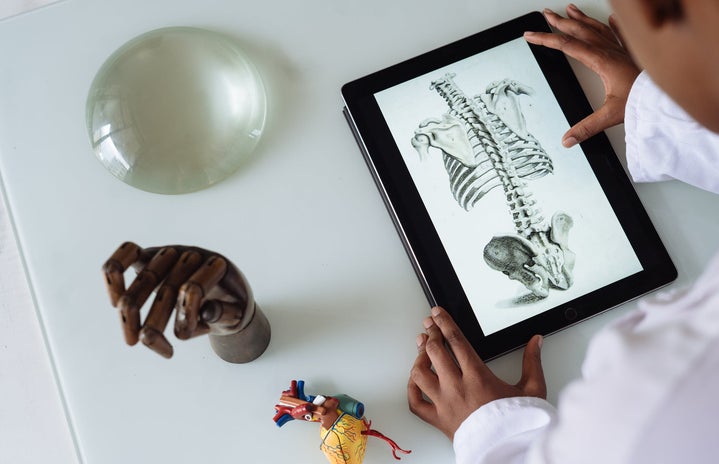You know how it goes. One moment, you’re suspended safely in the bubble of numbers and concrete facts that science never seems to be short on—the next, you’re being told that you need to write a paper about virus juice, and it counts for 40% of your grade.
The problem is this: you are a stem major. You do calculations and memorize facts about atoms, or cells, or Newton’s laws of motion. You slap together lab reports that consist of scribbled math and a hasty conclusion you ripped straight from the instructor’s PowerPoint presentation. You heard the words “scientific style citation” and astral-projected back to 10th grade English, when your APA-instead-of-MLA bibliography made your GPA, and subsequently your soul, sink through two layers of the earth’s crust. You don’t write, and quite frankly, you’re kind of scared of what would happen if you tried.
Well, for all the non-writing stem majors out there, your call has been heard and answered. In this article, I’m going to be walking you through the basics of scientific writing and breaking down the different sections of a scientific paper, to get you the A you deserve.
Let’s dive in.
If you recall writing lab reports in middle and high school, then you’ll remember that they tended to follow the scientific method structure: a question, some research, a hypothesis, a procedure, the results, and then a conclusion.
A scientific paper, while similar in some respect, is much more detailed and intensive. Scientific papers are divided into five main sections: the introduction, the methods and materials, the results, the discussion, and references. They also have an abstract, which basically serves as the summary.
TITLE
The title of the paper is a small but important piece. It should be the most significant result or finding.
For example, if you performed an experiment in which the path of a bottle rocket’s flight was observed and analyzed, a proper title would be “Bottle Rocket Flight Pattern Identified to Follow a Parabola Curve”. Something vague, like “Flight Patterns of a Bottle Rocket”, would not be appropriate.
ABSTRACT
Consider the abstract a spoiler for everything in your paper. This is where you want to summarize all of the other sections. Your reader should theoretically be able to read your abstract and know what your experiment is about, how you did it, what you found, and why you found it.
Since you’re not writing a book, there’s no need for any sort of hook or plot twist, or to withhold any important information from your reader for later. Just tell them what they need to know, without any fanciful flair.
INTRODUCTION
The introduction is the “background knowledge” portion of the paper. To compare to the scientific method, this would be where the question is brought forth, the research is described, and the hypothesis (if there is any) is stated.
The introduction should tell the reader about what you’re studying and why it’s important. You should also include information that will help others understand your experiment and results. However, research that is not directly relevant to the understanding of your methods and results should be omitted, even if it is related to what you are studying.
Outside sources and figures can be used to explain your topic of study to the reader, but if they are included, in-text citations in the format of (Author, Year) should be used. If you wanted to cite an article written in 2020 by Esteemed Scholar, the citation would be (Scholar, 2020). More than two authors would be written as (Scholar et. al., 2020). “Et. al.” is short for the Latin phrase et alia, which means “and others”.
Figures must also include a complete figure legend. More on those later.
Unlike an English paper, any information from outside sources should be paraphrased, not directly quoted. Just as all the teachers say, put it in your own words!
MATERIALS AND METHODS
“Materials and methods” is just a fancy way of saying procedure. This is where you describe the experimental process you used in enough detail for another person to be able to repeat it. If there are multiple experiments, they should be separated under different subheadings.
Since as of the time you are writing your paper, you have already completed the experiment, everything should be written in past tense using third-person or the passive voice.
- Third-person — “We added 3 grams of sodium chloride salt to 10mL of water.”
- Passive voice — “3 grams of sodium chloride salt were added to 10mL of water.”
Unlike in a scientific method lab report, you won’t be listing out the materials you used in your experiment. If someone were to read the examples above, they would be able to assume that sodium chloride salt and water were used; it would be redundant to include them in a separate list.
RESULTS
As the title states, this is where you state the results of your experiment(s). The section should include text to describe what those results were, as well as relevant figures such as pictures or graphs.
For every major experiment, there should be at least one figure. The figures should be cropped to only show the amount of information necessary. Arrows and circles can be added using software to point out important data to the reader.
Every figure comes with a figure legend. The figure legend title should be bolded and state the figure number and the result shown. Similar to the title of the paper, it should be specific and not just say the name of the experiment. The text of the legend describes the experiment that was done, as well as the result.
An example of a short figure legend for a plaque assay is shown below:
- Figure 1A. Plaque assay of 10-8 dilution shows 17 clear plaques. 1:10 serial dilutions were made using a high titer lysate and plaque assays were performed on the 10-6, 10-7, and 10-8 solutions. The plates were incubated at 37°C for 24 hours.
The results should not be interpreted, only stated. Interpretation is saved for the discussion portion of the scientific paper.
DISCUSSION
Oftentimes, this is merged with the results to create a “Results and Discussion” section, but some papers separate the two.
The discussion includes three parts:
- The explanation of the results
- The importance of the results
- The recommended future steps that could be taken with the data
The discussion section ties back to the introduction, using the background information you provided the reader earlier to explain what the results of your experiment(s) mean and the implications of them.
Why are your results significant? What bigger picture do they contribute to the scientific community? What could someone else do with the data that you have gathered? No scientist conducts research or performs experiments for no reason, so these are the questions that the discussion section answers.
REFERENCES
This serves as your bibliography, where all the sources of any information you referenced earlier in the paper go. Typically, scientific style citation is used. The Scientific Style and Format Citation Quick Guide is a good resource to help properly cite anything from a scientific journal to a DVD.
Overall, scientific writing is straightforward and, in all honesty, rather plain. As the objective is to deliver information instead of entertain, there’s no need to worry about trying to make it attractive or interesting to read. In fact, succinctness is encouraged; wordiness has no purpose, and so if you can say the same thing in fewer words, then you should do it.
Otherwise, as long as you convey the necessary information to the reader in the correct sections, you’re bound to get a gold star.


